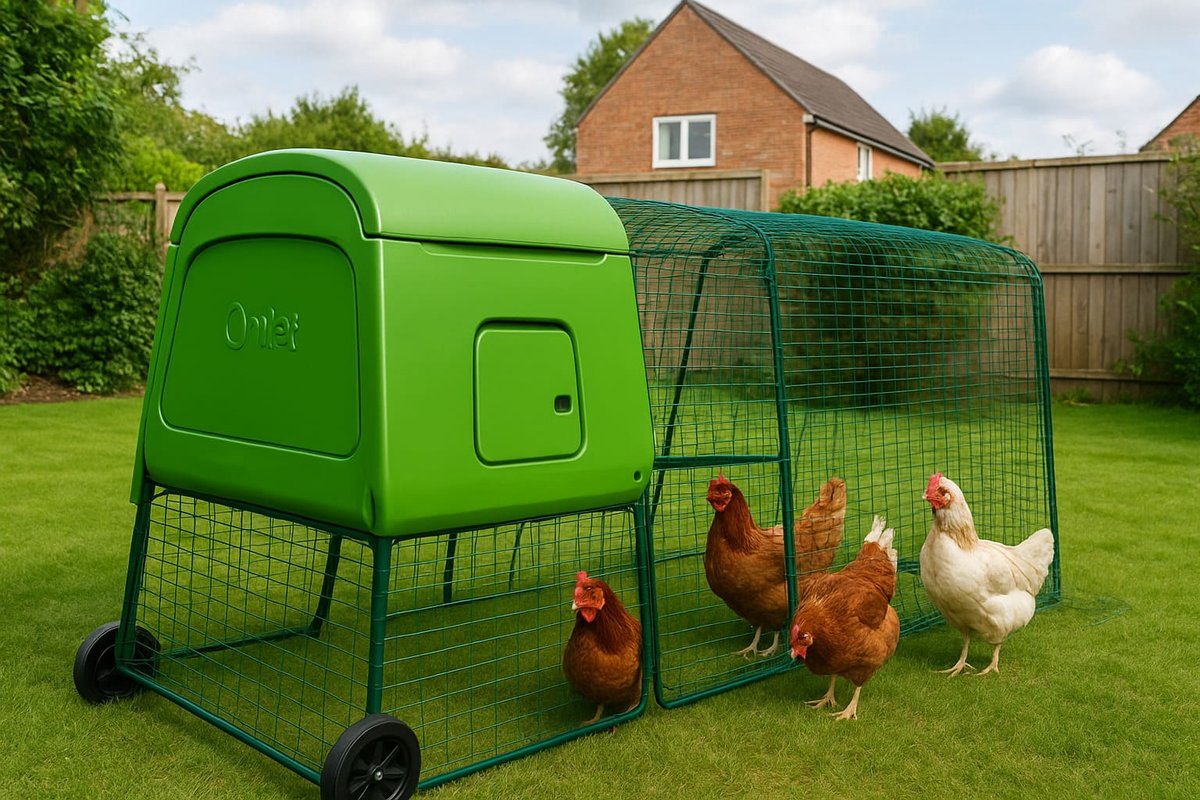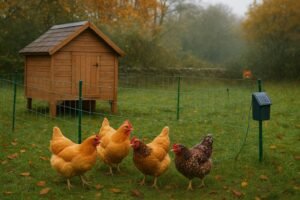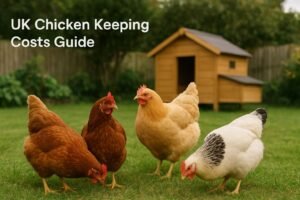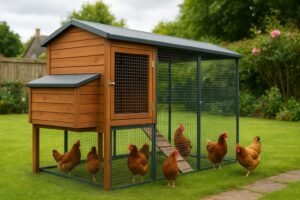The Omlet Eglu Cube takes 2.5 to 3 hours to assemble with two people for the coop only. Adding wheels and a run extension extends assembly time to 3-4 hours. While Omlet’s official estimate is 2 hours, this realistic timeframe accounts for checking parts, following instructions carefully, and ensuring proper alignment.
Here is a step-by-step guide to assembling an Omlet Eglu Cube, designed to help UK chicken keepers get it right the first time. If you’ve just had a big delivery from Omlet, you might be wondering what you’ve got yourself into. Don’t worry, it’s easier than it looks!
So, how long does it take to assemble an Omlet Cube? Let’s be honest. Omlet’s official manual says about 2 hours, but from my experience, that’s just for the coop itself and if you’re very quick. For most of us, it’s safer to plan for 2.5 to 3 hours with two people. If you’re also adding the wheels and a run extension, set aside a full afternoon—closer to 3 or 4 hours.
I’ve built three of these coops in my time (you can read my full Omlet Eglu Cube review here), and I’ve learned a few tricks along the way. This guide will walk you through the entire build process, from opening the boxes to making final checks, all with UK keepers in mind. You can use this alongside Omlet’s official instruction manual (PDF) and Omlet’s official assembly video for extra help.
What You’ll Need Before Starting
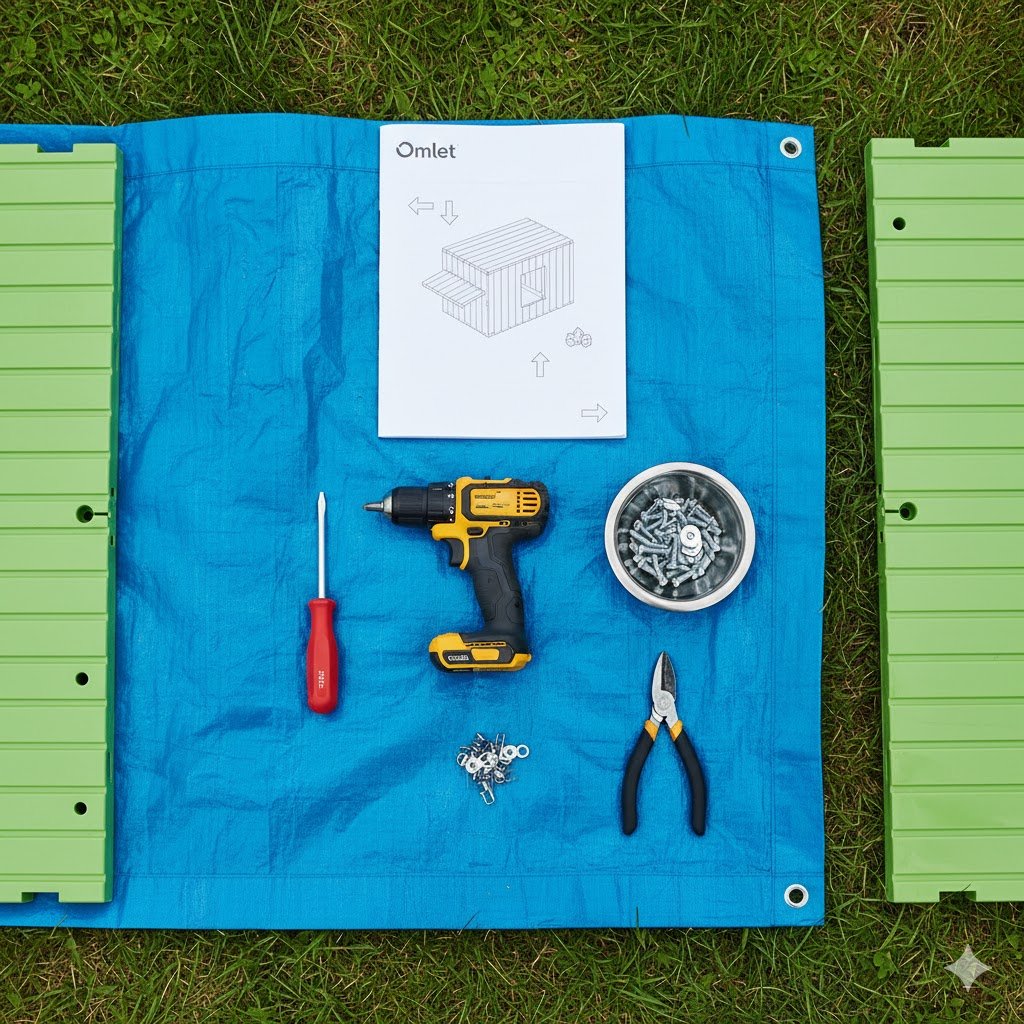
Before you break the seals on those boxes, a little prep goes a long way. It makes the whole Eglu Cube setup time feel much shorter.
Tools Required (and What You Don’t Need)
The great news is you don’t need a full workshop.
- Essential: A good quality Phillips head screwdriver. A standard “PH2” size is perfect for all the bolts. I’d recommend one with a comfortable grip, as you’ll be using it a lot.
- Very Helful: An electric screwdriver or drill on a low torque (power) setting. Warning: Be very careful with this. Set the torque low so it stops spinning before it strips the plastic. It’s a real time-saver.
- Also Handy:
- Wire Snips: To cut the many cable ties on the packaging.
- A Small Bowl: To put all your bolts, washers, and clips in. Losing a key clip in the grass is a very frustrating experience!
- What you DON’T need: A drill (for making holes), a saw, a hammer, or any complex tools. This is a beginner-friendly kit.
A Helper? Yes, Seriously.
I’ve built one alone, and I wouldn’t recommend it. I’d say this is a two-person job, especially for a first-timer. You’ll need a helper to:
- Hold the frame pieces steady while you add the first bolts.
- Hold the large wall panels in place.
- Tackle the roof (the trickiest bit), which really needs one person pushing down and one person aligning from inside.
Choosing Your Location Before You Build
This is a step many people miss. Where you build it is as important as how.
- Find Level Ground: Assembling it on a slope or bumpy lawn is a nightmare. The frame won’t sit square, and the run panels won’t align. A patio, level bit of lawn, or decking is ideal.
- Think About UK Weather: Don’t place it in the windiest corner of your garden. Try to find a spot with some shelter from driving rain and hot summer sun. Under a tree (but not one that drops loads of debris) or against a sheltered fence is often good.
- Access for Cleaning: Remember you’ll need to pull the droppings tray out from the back. Leave enough space to get a wheelbarrow or garden tub right up to it.
- Ground Type: If it’s on grass, you’ll need to move it every few days. For a permanent spot, many UK keepers put the whole thing on paving slabs or a deep bed of woodchips to prevent a mud pit in winter.
Unboxing and Getting Organised
Your coop will arrive flat-packed in several large boxes, usually labelled Box A, Box B, Box C.
- Check List: Open them all. Find the instruction manual and the parts list. I recommend laying everything out (a tarp on the grass is great for this) and checking you have all the main components before you start.
- Group Parts: Put all the run panels in one pile, the house panels in another, and keep your hardware bag safe (the one with all the bolts and clips). This saves you hunting for parts later.
Getting your prep right is half the battle, and you’ll thank yourself for it. Once you’re organised, it’s time to see exactly what’s what in those boxes.
Understanding Your Eglu Cube Components
When you first unbox everything, it can feel overwhelming. Here’s a quick checklist of the main groups of parts you should have. Don’t worry about counting every single bolt and clip just yet—they come in clearly labelled bags.
- The Stand & Frame: These are the metal parts that form the stand, including the legs and the rectangular base frame. If you bought wheels, you’ll have the wheel assembly and foot pedals here too.
- The House Panels: The colourful main body of the coop. This includes the front panel (with the door hole), the solid back panel, the two side panels, and the roof/lid sections. You’ll see they are all double-walled plastic for that all-weather insulation. (The Cube accommodates 6 large hens, 8 medium breeds, or 10 bantams—see our guide to popular UK chicken breeds if you’re still deciding).
- The Internal Parts: This is the clever bit. You’ll have the large, slide-out droppings tray, the plastic roosting bars (which look like a slatted rack), and the nest box partition.
- The Run & Hardware: If you purchased a run, this will be a large pile of green mesh panels. You’ll also have the anti-dig skirt panels (the L-shaped ones) and lots of bags of clips. Your main hardware bag contains all the bolts, washers, and brackets for the house.
Taking a moment to identify these main parts makes the manual much easier to follow. Now, let’s grab that screwdriver and get building.
Step-by-Step Assembly Instructions
Right, let’s get building. Follow the Omlet Eglu Cube assembly instructions (the paper manual) closely, and use my tips below to help with the tricky bits.
Step 1: Assembling the Base Frame
This is the foundation of your coop. You’ll be connecting the metal legs and support bars to create the rectangular stand.
- Time: About 30-40 minutes.
- Pro Tip: Do Not Overtighten! This is my biggest tip. Put all the bolts in “finger tight” first. Leave them a little loose until the whole frame is built. This gives you “wiggle room” to make sure everything is square.
- Why? If the frame isn’t perfectly square, you’ll have problems later. The main one is the droppings tray will stick and be hard to pull out. Once it’s all together, go back and tighten all the bolts.
Step 2: Attaching the Wheel Assembly (if applicable)
If you bought the wheels (a great choice for a mobile chicken tractor), now is the time to add them.
- Action: You’ll bolt the wheel units to the legs, following the diagram carefully.
- Common Mistake: Make sure you attach the foot pedals the right way up. It’s easy to get them reversed.
- Pro Tip: Once it’s built, test the mechanism. Press the foot pedals and check the frame lifts evenly. It’s much easier to fix any issues now before the 30kg+ house is on top of it!
Step 3: Building the Coop Housing
Now for the colourful bit! You’ll attach the front face, side panels, and rear panel to the base.
- Tip: This is where your helper is essential. Get them to hold the panels straight while you fit the brackets and bolts.
- Alignment: The panels slot together with a “hook and runner” system. Make sure these are properly seated before adding bolts. The double-walled plastic provides great insulation, but only if the seals are tight.
- Check: Make sure the large opening at the back panel lines up perfectly with the frame. This is where your droppings tray will slide in.
Step 4: Installing the Roof and Lid
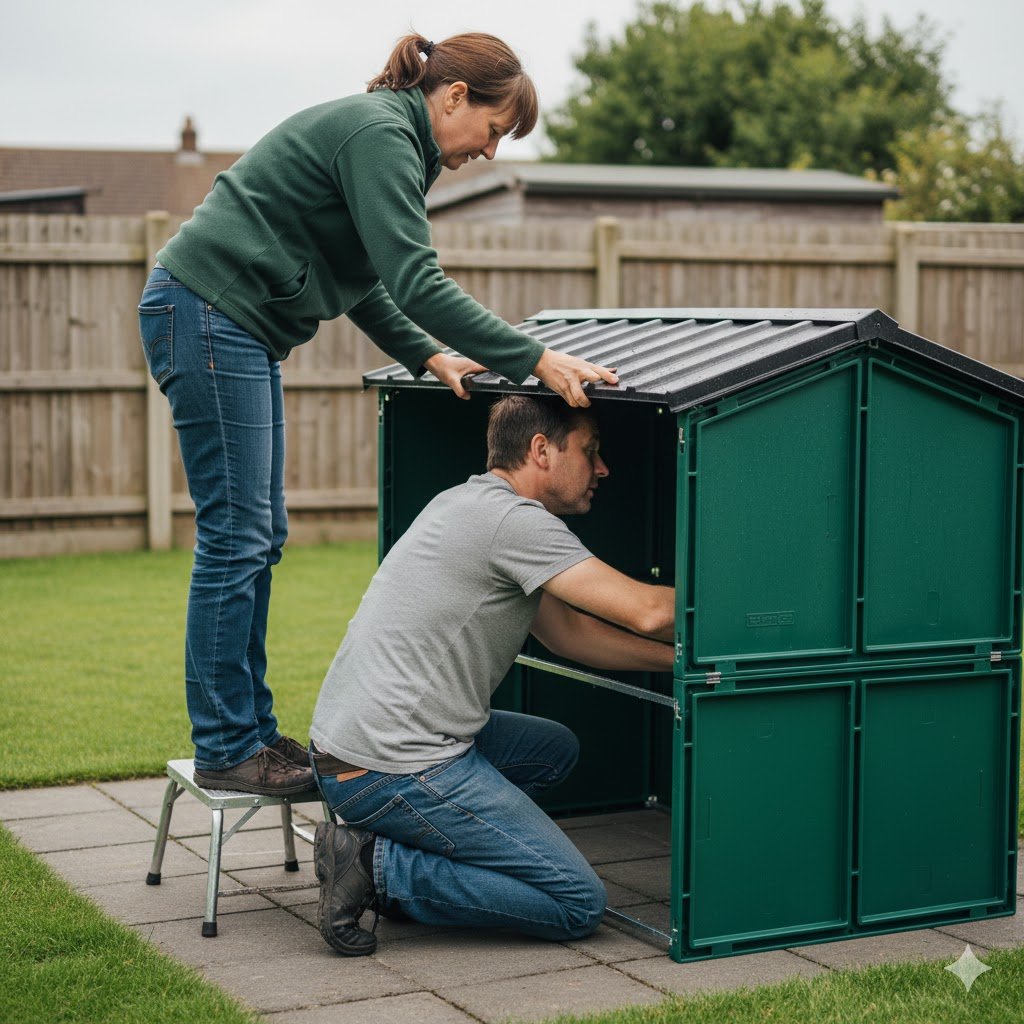
This is the most common challenge, so be patient.
- The Challenge: The roof (especially the black inner ‘skin’) can feel very stiff and hard to fit. This is normal! It’s designed that way to be weatherproof and strong.
- UK Keeper Tip: I find it helps to assemble this on a warmer, sunny day if possible. The plastic is slightly more flexible, which makes all the difference.
- Two-Person Technique: This is non-negotiable for me. One person should push down firmly and evenly on the roof panel from above. The other person works from inside the coop to align the clips and bolts.
- Check the Seal: Before you bolt it down, look at the rubber seal around the edge. Make sure it hasn’t twisted or popped out of its channel.
Step 5: Adding Internal Components
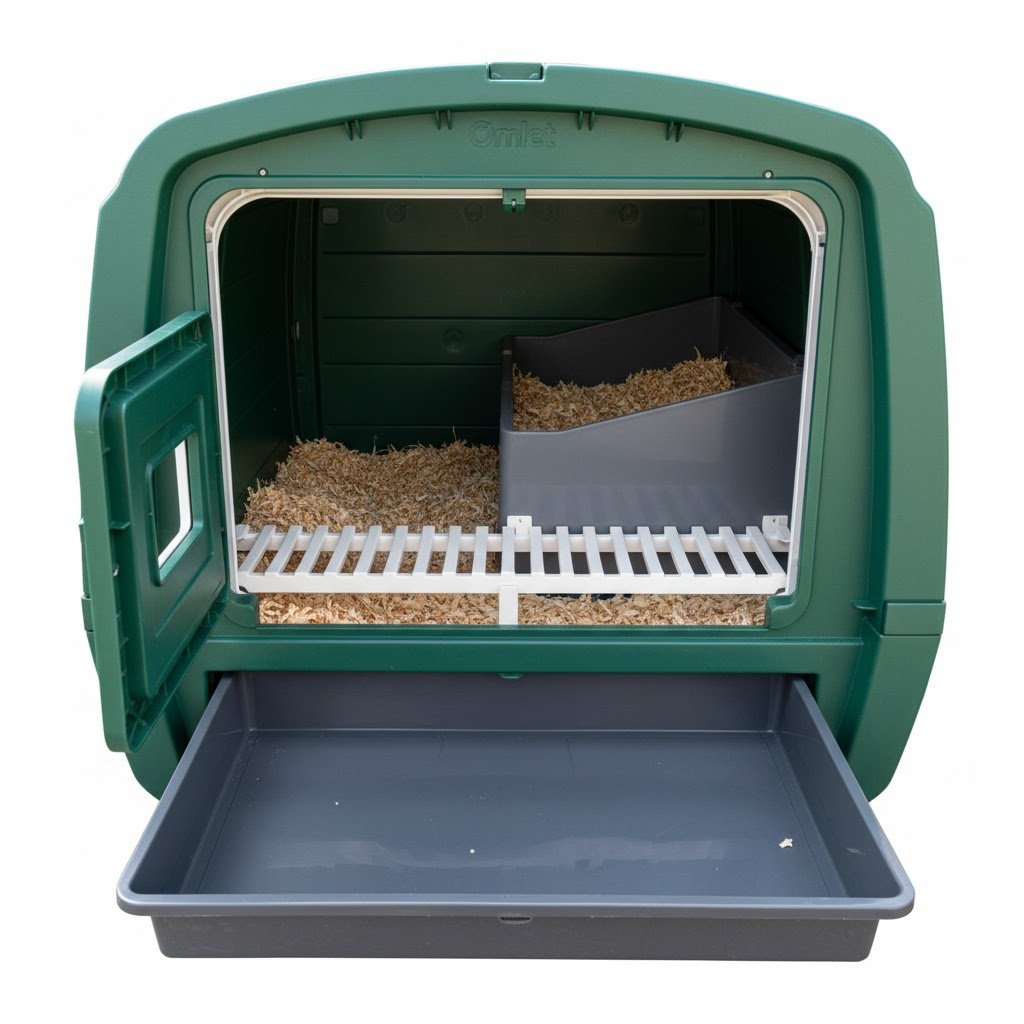
This is the easy and satisfying part.
- Action: Simply slide in the droppings tray (it should glide smoothly if your frame is square). Place the roosting bars rack on top of the tray guides, and fit the nest box partition into its slots.
- Check: Make sure the rear door (which gives you access to the egg port) opens and closes smoothly.
Step 6: Connecting the Run Extension (if purchased)
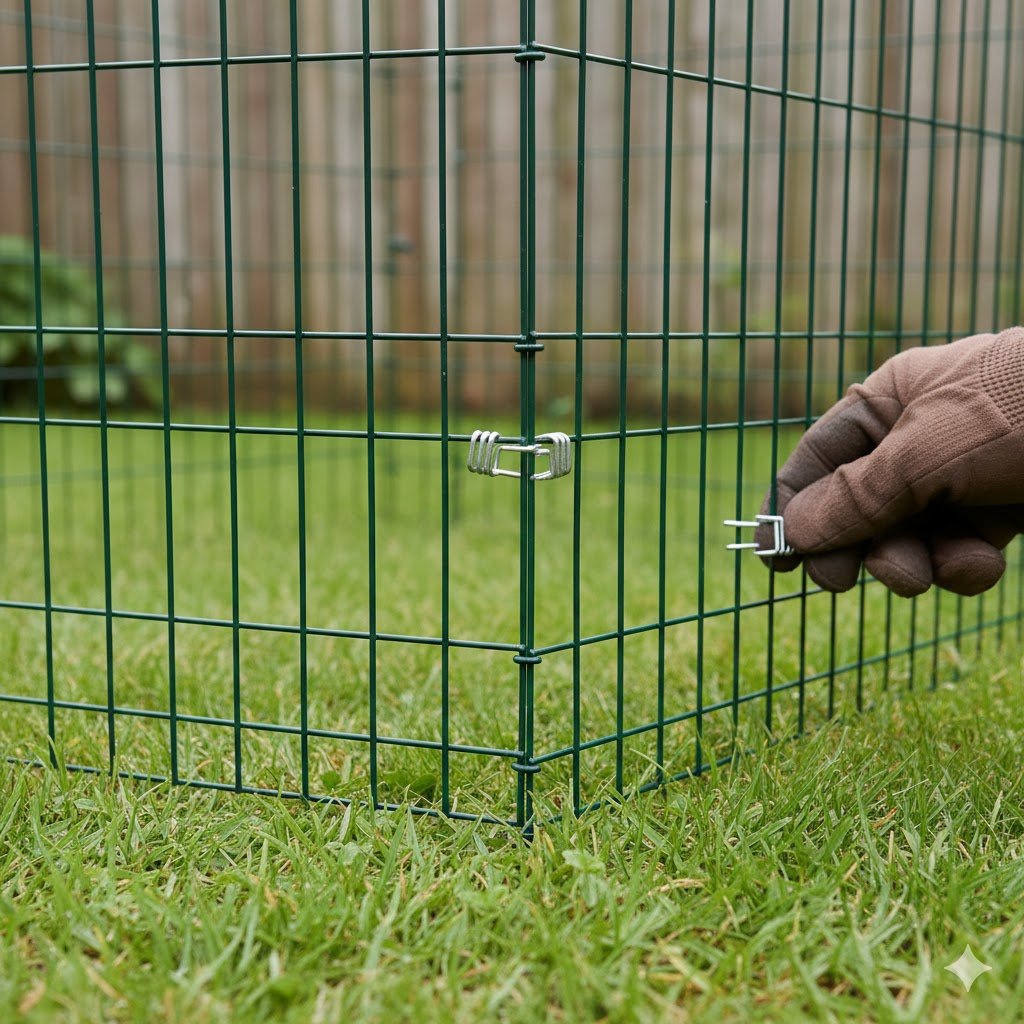
If you have a run, this is the final stage. The Eglu Cube run installation uses a lot of special clips. Be patient, and maybe wear gloves!
Assembling the Run Panels
- Pro Tip: Use temporary cable ties (zip ties)! It’s much easier to loosely connect the run panels together with a few cable ties first. This holds the shape, and you can then go back and add the permanent (and much stronger) run clips.
- Ground: Assemble the run on the same level ground as the coop.
Attaching the Anti-Dig Skirt
- Crucial Step: The anti-dig skirt (the L-shaped mesh panels) must be at the bottom, facing outwards on the grass. This is the main predator protection feature, as it stops foxes and badgers from digging in.
The Art of the Fiddly Run Clips
- Get a Bowl: Put all your clips in a bowl. Don’t leave them on the grass.
- The Technique: The Omlet manual shows this well. You place the clip over the two wires and squeeze with your thumb and forefinger. You are looking for a satisfying “click” to know it’s locked.
- Be Patient: This takes time, and your thumbs will get sore. Take breaks!
Connecting the Run to the Coop
- No Gaps: The run attaches directly to the coop frame using special ‘P-clips’. Make sure this connection is secure and there are absolutely no gaps a predator could squeeze through.
- Door Check: Check the run door and the door connecting the run to the coop align and lock properly.
With the run attached, the hard work is over. This assembly is a one-time job, and thankfully the easy to clean design is your reward for years to come. If you’re new to chicken keeping, check out our complete guide to keeping chickens in the UK for everything you need to know about caring for your new flock.
How Long Does It Take to Assemble an Omlet Cube? Real User Experiences
This is one of the most common questions, so let’s break down the Eglu Cube setup time based on real customer reviews and my own experience.
Here’s a simple comparison table to set your expectations:
| Configuration | Official Omlet Time | Real User Time (2 People) |
|---|---|---|
| Coop Only | ~ 2 hours | 2.5 – 3 hours |
| Coop with Wheels & Run | Not specified | 3 – 4 hours |
- Working Alone: This is a key factor. While possible, expect it to take 3+ hours for just the coop, and 4.5+ hours with the run. The roof is very tricky solo.
What Can Slow You Down?
- Uneven Ground: The #1 reason for panels not aligning.
- Weather: Wind and rain are not your friends.
- Tightening Too Soon: Being over-eager with the screwdriver on the frame.
- Losing Parts: Dropping a key bolt in the grass.
- Ignoring the Manual: Trying to “wing it”. The Omlet videos are also a massive help.
What Can Speed You Up?
- A Good Helper: The ultimate upgrade.
- An Electric Screwdriver: Used carefully on a low torque setting.
- Pre-Sorting: Organising all your parts before you start.
- Watching the Omlet Video: Seeing it done first makes the paper manual much clearer.
Understanding the real-world timings helps you plan your day. Now, let’s look at the specific problems you might face and how to solve them.
Common Assembly Challenges and Solutions
Even though this is an easy chicken coop assembly overall, here are the common bits where people get stuck.
1. The Stiff Roof Fit
- Problem: The roof panel feels too big or won’t slot into place.
- Solution: It will fit. As mentioned in Step 4, don’t be afraid to use firm, steady pressure. Have one person push down from the top (not just the edge) while the other aligns it from underneath. A warmer day also helps.
2. Run Panels Not Aligning
- Problem: The run panels have gaps or won’t line up.
- Solution: This is almost always due to uneven ground. Assemble the run on the flattest spot you can. The temporary cable tie trick also helps pull panels into line before you add the permanent clips.
3. Droppings Tray is Sticking
- Problem: The tray is very stiff to pull out or push in.
- Solution: Your base frame is not square. Go back to the metal frame, loosen all the bolts, give it a “wiggle” to get it into a perfect rectangle, and re-tighten the bolts on a level surface. This fixes it 99% of the time.
4. The Fiddly Run Clips
- Problem: The clips are hard to close and hurt your thumbs.
- Solution: Wear gardening gloves. Make sure you are using the clip the right way round (the manual shows a diagram). Squeeze from the ‘hinge’ side. It’s a marathon, not a sprint!
5. “I’ve Used the Wrong Screw!”
- Problem: A bolt is just spinning and won’t tighten.
- Solution: You’ve likely used a screw that’s too long or short in the wrong place. Don’t force it. Take it out, check the manual very carefully (the diagrams show which bolt goes where), and swap it. Omlet is usually generous and includes a few spares, just in case.
6. Building in Bad British Weather
- Problem: It’s raining, and the cardboard boxes are turning to mush.
- Solution: Given the lovely British weather, I recommend assembling in a garage, carport, or shed if you can. If you must build it outside, wait for a dry day and get the parts off the lawn and onto a tarp quickly.
Knowing these common issues in advance can save you a lot of hassle. Once you’re past them, you’re on the home stretch.
Post-Assembly Checklist
You’ve done it! Your Eglu Cube is built. Before you introduce your flock, do these final quick checks.
The “Wiggle Test”
Give the whole coop and run a good shake. Does it feel sturdy and solid? If it’s wobbly, go back and tighten your frame bolts and check your run clips.
The “Fox-Proof” Door Check
This is vital. Check all doors and locks:
- The main coop door (the twist-handle).
- The rear egg port door.
- The door at the end of your run. Do they all lock securely? Are there any gaps? You can even upgrade to an automatic door later.
The “Smooth Operator” Internal Check
Slide the droppings tray and roosting bars in and out. They should move easily. If not, your frame isn’t square (see challenge #3).
The Wheel Test
If you have wheels, press the foot pedals one more time. Does the coop lift smoothly and evenly?
Getting it “Hen-Ready”
Now for the fun bit.
- Register Your Flock: This is a legal requirement. All keepers of 50 or fewer birds in England, Scotland, and Wales must register your flock with DEFRA/APHA within one month of getting them.
- Bedding: Add a good layer of dust-extracted wood shavings or similar bedding to the nesting box area (see our guide on the best bedding for UK conditions if you’re unsure).
- Positioning: Move the coop to its final position.
- Food & Water: Fill the feeder and drinker (if you bought them) and clip them to the run (check our complete supplies checklist if you’re not sure what you need).
- Let it Air: Leave the doors open for an hour or so on a dry day just to air it out before your chickens move in.
Once you’ve ticked these boxes, you’re ready to welcome your first backyard chickens!
FAQ on A Step-by-Step Guide to Assembling an Omlet Eglu Cube
Here are quick answers to the most common questions from new owners.
How long does it take to assemble an Omlet Cube?
Expect 2.5 to 3 hours for the coop with two people. If you are also building the wheels and a run, set aside 3 to 4 hours.
Can I build the Eglu Cube alone?
You can, but it’s much harder and will take longer. The roof section is a very difficult two-person job, so I’d recommend grabbing a friend.
What tools do I need?
Just one! A good quality Phillips head screwdriver (PH2 size) is all you need. An electric screwdriver (on low!) and some wire snips are also very helpful.
Is assembly difficult for beginners?
Honestly, no. It’s designed to be beginner-friendly. The instruction manual has clear pictures, and there’s no sawing or drilling. If you can build flat-packed furniture, you can build this (you can see my Omlet vs. Framebow comparison for more details). The run clips are the most fiddly part.
Is the Eglu Cube really fox-proof?
Yes, I trust mine completely (I rate it as one of the best fox-proof coops in the UK). It’s fox-proof if it’s assembled correctly. This means all clips are secure, all doors are locked, and the anti-dig skirt is on the outside, flat on the ground. When assembled correctly, the coop provides a safe environment that meets UK animal welfare guidelines for protection from predators and the elements.
What’s the best base for the Eglu Cube in the UK?
On grass is fine, but you must move it every few days to stop it from becoming a mud pit (we have a whole guide on solutions for muddy chicken runs). For a permanent spot, I’d always recommend either paving slabs or a deep (6-inch) bed of bark woodchips.
What are the main UK rules for keeping chickens?
The most important one is registering your flock. You also need to follow animal welfare laws. A big one to remember is that it’s illegal to feed your chickens kitchen scraps (to prevent disease). For a full overview, check Omlet’s guide to UK chicken keeping regulations and this independent guide to British poultry regulations.
How do I maintain it after assembly?
This is the best part. Unlike wooden coops, maintenance is almost zero. The plastic is easy to clean—just hose it or wipe it down. The slide-out droppings tray makes daily cleaning a 2-minute job. This is a massive help with red mite prevention (check our guide on red mite prevention and treatment here)!
Your Next Steps
Congratulations on building your Omlet Eglu Cube! You’ve given your flock a safe, comfortable, and easy-to-clean home. Now that your coop is built, your next adventure in chicken keeping begins. For brilliant ongoing care advice, explore Omlet’s complete chicken keeping guide to learn about feeding, health, and more.

Oladepo Babatunde is the founder of ChickenStarter.com. He is a backyard chicken keeper and educator who specializes in helping beginners raise healthy flocks, particularly in warm climates. His expertise comes from years of hands-on experience building coops, treating common chicken ailments, and solving flock management issues. His own happy hens are a testament to his methods, laying 25-30 eggs weekly.
